MANITOBA


ORIGIN OF PROVINCE NAME: Likely comes from either the Cree Indian manitowapow or the Ojibway Indian Manitou bou (both of which mean "the narrows of the Great Spirit"). The words referred to Lake Manitoba, which narrows to less than 5/8 of a mile (1 kilometer) at its center. The waves hitting the loose surface rocks of its north shore produce curious bell-like and wailing sounds, which the first Aboriginal Peoples believed came from a huge drum beaten by the spirit Manitou.
NICKNAME: Keystone Province.
CAPITAL: Winnipeg.
ENTERED CONFEDERATION: 15 July 1870.
MOTTO: Gloriosus et liber (Glorious and free).
COAT OF ARMS: In the center, the provincial shield of arms displays in the lower two-thirds a buffalo standing on rock on a green background, symbolizing Manitoba's prairie nature and the historically important Red River buffalo hunt. The red Cross of St. George appears in the upper third and represents the province's bond to the United Kingdom. Above the shield is a crest with a red-and-silver-mantled gold helmet and a beaver holding a pasqueflower and carrying a royal crown on its back. Supporting the shield on the left is a unicorn with a green and silver collar from which hangs a Red River cart wheel. A white horse supports the right side and wears a bead and bone collar from which hangs an Indian symbol. Beneath the shield are displayed grain, pasqueflowers, white spruce trees, and symbols for water. The provincial motto appears on a scroll at the base.
FLAG: On a field of red, the Union Jack (the flag of the United Kingdom) occupies the upper quarter on the staff side. The provincial coat of arms is centered in the half farthest from the staff.
FLORAL EMBLEM: Pasqueflower, known locally as prairie crocus.
TARTAN: Manitoba Tartan (maroon and green, with yellow, dark green, and azure blue).
PROVINCIAL BIRD: Great gray owl.
TREE: White spruce.
TIME: 6 AM CST = noon GMT.
1 LOCATION AND SIZE
Manitoba is bordered by Nunavut to the north, Hudson Bay to the northeast, Ontario to the east, the US states of Minnesota and North Dakota to the south, and Saskatchewan to the west. Manitoba, along with Alberta and Saskatchewan, is one of the three prairie provinces and is located in the center of Canada. Manitoba's total area is 261,000 square miles (676,000 square kilometers), with a total land area of 212,000 square miles (548,000 square kilometers).
2 TOPOGRAPHY
Elevations rise slowly from sea level at Hudson Bay to the higher areas of the south and west. Most of Manitoba lies between 500 and 1,000 feet (150 and 300 meters) above sea level. But in the Turtle, Riding, Duck, and Baldy Mountains, heights rise to 2,300 feet (700 meters) or higher. The highest point in Manitoba is Baldy Mountain, in Duck Mountain Provincial Park, at 2,726 feet (831 meters).
Manitoba is known as the land of 100,000 lakes, a legacy of enormous Lake Agassiz, which covered much of the province after the glaciers retreated. Lake Winnipeg, Lake Winnipegosis, and Lake Manitoba dominate the southern topography; Lake Winnipeg is the fifth-largest freshwater lake in North America. The north shows enormous changes from the glaciers' movements and is covered in forest.
Manitoba Population Profile
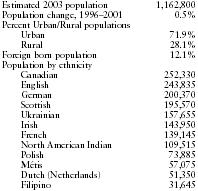
| Estimated 2003 population | 1,162,800 |
| Population change, 1996–2001 | 0.5% |
| Percent Urban/Rural populations | |
| Urban | 71.9% |
| Rural | 28.1% |
| Foreign born population | 12.1% |
| Population by ethnicity | |
| Canadian | 252,330 |
| English | 243,835 |
| German | 200,370 |
| Scottish | 195,570 |
| Ukrainian | 157,655 |
| Irish | 143,950 |
| French | 139,145 |
| North American Indian | 109,515 |
| Polish | 73,885 |
| Métis | 57,075 |
| Dutch (Netherlands) | 51,350 |
| Filipino | 31,645 |
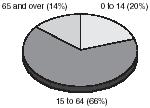

| City | Population, 2001 |
| Winnipeg | 626,685 |
| Brandon | 39,716 |
| Thompson | 13,256 |
| Portage la Prairie | 13,019 |
3 CLIMATE
Manitoba is one of the sunniest provinces in Canada. It has what is known as a continental climate, which features great temperature extremes. Summer temperatures in Manitoba range from an average of 62–75°F (17–24°C) in June to 45–65°F (8–18°C) in September. Winter temperatures average 8 to 30°F (-13 to 0°C). Typical of southern Manitoba, the normal daily January temperature in Winnipeg is about -4°F (-20°C), while the normal daily July temperature is about 66°F (19°C). In Thompson, in the center of northern Manitoba, the normal daily temperature ranges from about -17°F (-27°C) in January to 59°F (15°C) in July. The warmest recorded
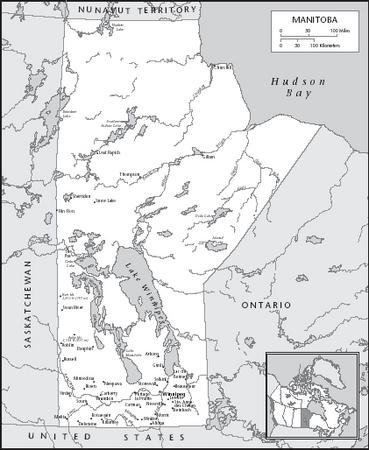
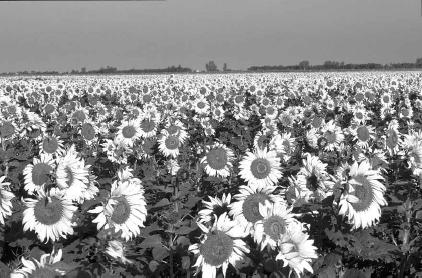
4 PLANTS AND ANIMALS
There are remnants of the native prairie grasses in protected areas of the central plains. Basswoods, cottonwoods, and oaks are common tree species there. Pelicans, beavers, raccoons, red foxes, and white-tailed deer are commonly found near Lake Manitoba; bison were once numerous there too but now exist only in small herds in protected areas. Some 27 species of waterfowl nest in southern Manitoba through the summer, and fall migrations bring thousands of ducks and geese. Polar bears and beluga whales are native to the Churchill area.
5 ENVIRONMENTAL PROTECTION
The Manitoba Division of the Environmental Protection Branch of Canada's Ministry of the Environment is responsible for enforcing the Canadian Environmental Protection Act (CEPA) and regulations; enforcing the pollution prevention provision of the Fisheries Act (FA) and regulations; being prepared to respond to environmental emergencies; and for promoting or providing advice regarding compliance, pollution prevention, and other Environment Canada environmental initiatives to federal government departments, industry, and the public and private sector. Manitoba annually releases about 583,000 tons of nitrogen dioxide and carbon monoxide (gases that cause smog), 554,000 tons of sulfur dioxide and nitrogen oxide compounds, and the equivalent of 3.4 million tons of carbon dioxide. Manitoba generates about 0.8 percent of Canada's annual hazardous waste, and creates about one million tons of solid waste (0.8 tons, per resident) each year.
In 2002, Manitoba began a project to help reduce the amount of consumer electronic products going into Manitoba landfills. The project received a C$50,000 grant from Manitoba Conservation's Sustainable Development Innovations Fund to reduce the amount of "E-waste." It was estimated that Manitobans would throw out 2,680 tons of personal computers by the year 2005. This was added to the number of old televisions, cell phones, and other electronic products that are disposed of when they are replaced or updated by consumers.
6 POPULATION
As of 2001, about 56 percent of Manitoba's 1.12 million people lived in metropolitan Winnipeg, the provincial capital. The Winnipeg metropolitan area is the eighth-largest in Canada. The second-largest city is Brandon, in southwestern Manitoba, with 39,716 people. Other cities in the province are Thompson, Portage la Prairie, Selkirk, Steinbach, Dauphin, Winkler, and Flin Flon.
The median age of Manitoba's population increased 3.8 years from 1991 to 2001, from 33 years to 36.8. This was a record increase. The high fertility rate of the Aboriginal population keeps the median age below Canada's average, however. Canada's median age is 37.6 years. In 2001, seniors age 65 and over made up 14 percent of the population.
7 ETHNIC GROUPS
Although Manitoba is one of the smaller provinces in population, it is an important center for a number of ethnic groups. It is one of the most important centers of Ukrainian culture outside Ukraine. It also has one of the largest populations of Mennonites in the world. There was a Filipino population of 31,645 in 2001. Almost 166,600 people (15 percent) trace their ancestry to Aboriginal Peoples or Métis (people of mixed Aboriginal and European ancestry). Winnipeg has the largest French community outside of Québec. Gimli has the largest Icelandic community anywhere outside of Iceland.
8 LANGUAGES
In 2001, 74.6 percent of all residents reported English as their mother tongue, while 4 percent claimed French. Other first languages—including German, Ukrainian, and various indigenous languages—were reported by 20 percent of Manitobans. The remaining 1.4 percent had two or more native languages.
9 RELIGIONS
Over 43 percent of all Manitobans—449,195 people—are Protestant. The leading Protestant denominations are United Church of Canada, Anglican, Lutheran, Pentecostal, Baptist, and Presbyterian. The province has about 305,390 Catholics, or 27.7 percent of the population. About 15,645 Manitobans are of Eastern Orthodox faith and approximately 13,040 are Jewish. Buddhists, Muslims, Sikhs, and Hindus were also present, each with less than 6,000 followers. About 205,865 Manitobans—18.7 percent—report no religious affiliation.
10 TRANSPORTATION
The Trans-Canada Highway connects Winnipeg with Kenora, Ontario, to the east and with Portage la Prairie and Brandon to the west before continuing on to Saskatchewan. In 2003, Manitoba had 640,242 registered motor vehicles, 3,677 registered buses, 7,930 registered motorcycles and mopeds, and 97,074 registered trailers.
Urban transit systems operate about 600 motor buses. Winnipeg's bus service is called Winnipeg Transit.
Greyhound Bus Lines offers scheduled and chartered passenger bus service throughout Canada and the United States. Grey Goose Bus Lines and Beaver Bus Lines provide travel service in Manitoba only.
In 2000, Winnipeg International Airport served nearly 3 million arriving and departing passengers. Winnipeg is also a major hub for the two major railroad networks in Canada, Canadian Pacific Rail and Canadian National Rail.
11 HISTORY
Manitoba is the easternmost of Canada's Prairie Provinces, named for its level land. The Assiniboine Indians were the first inhabitants of Manitoba. Other tribes included the nomadic Cree, who roamed from place to place following the herds of bison and caribou on their seasonal migrations. The name Manitoba likely comes from either the Cree Indian manitowapow or the Ojibway Indian Manitou bou (both of which mean "the narrows of the Great Spirit"). The words applied to Lake Manitoba, which narrows to less than a kilometer at its center. The waves hitting the loose surface rocks of its north shore make unusual bell-like and wailing sounds, which the first aboriginal, or native, peoples believed came from a huge drum beaten by the spirit Manitou.
In their search for the rich Far East by means of the Northwest Passage, Europeans reached Manitoba through Hudson Bay. Unlike the majority of Canada's provinces, the northern parts of Manitoba were settled before the south. In the winter of 1612, Captain Thomas Button steered two ships to a point at the mouth of the Nelson River on Hudson Bay. Later, between 1733 and 1738, a party led by Canadian explorer Pierre Gaultierde La Vérendrye surveyed the Red and Winnipeg rivers and built several settlements there.
The Importance of the Fur Trade
Europeans became interested in Manitoba in the 17th century because of its promising
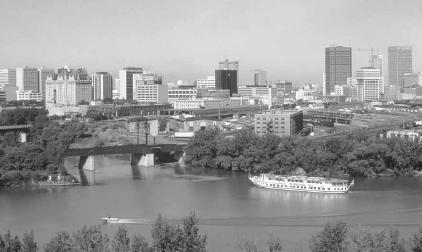
In 1812, Scottish colonists established the first European agricultural settlement in the area. The colonists were led by Lord Selkirk of the Hudson's Bay Company. Their settlement, known as Assiniboia, developed around the junction of the Red and Assiniboine rivers. The Selkirk colony suffered through floods, problems arising from unfamiliarity with the environment, and fur trade disputes. Nevertheless, it survived.
The Canadian government was anxious to expand its provinces into the great northwest and offered to buy the land from the Hudson's Bay Company in the 1860s. The native peoples of the region, known as the Métis (people of mixed French and Indian heritage), began to fear for the preservation of their land rights and culture. The Métis, under the leadership of Louis Riel, opposed the Canadian proposals in a conflict known as the Red River Rebellion. Riel succeeded in establishing a locally elected, temporary government in December 1869. In mid-July of 1870, this government negotiated terms with the new federal government of Canada, making Manitoba a province of the Dominion of Canada.
Gateway to the West
The new "postage stamp" province (so named because of its square shape and small size) consisted of 36,000 square kilometers surrounding the Red River Valley. However, the province did not remain that small; its boundaries were stretched in 1881 and again in 1912. Because of its central location as the entry point to western Canada, Manitoba grew quickly over the next half century. With the help of the railway, thousands of settlers from eastern Canada and from countries all over the world made Manitoba their home. By the early 1880s, the capital city of Winnipeg, located where the Assiniboine and Red rivers meet, became the centre of river and rail transport. In 1906, the first hydroelectric plant in the province was built on the Winnipeg River.
The prosperity of the early years of the twentieth century came to an end in 1913, when a major depression hit Manitoba. Wheat prices fell, freight rates rose, and the opening of the Panama Canal in 1914 gave Winnipeg serious competition as a trading center. Because goods could now be transported from east to west more cheaply by sea than by rail, Winnipeg lost its status as the prime gateway to western Canada. In 1919, workers in the metals and building trades in Winnipeg staged a strike to protest management problems.
The 1920s Bring Economic Problems
The small province of Manitoba lost around 7,800 soldiers in World War I (1914-1919). After the war, the remaining people of Manitoba faced a bleak future. Wheat prices fell 50 percent by 1920. Jobs were scarce and low-paying, and tariffs (taxes) on imported products kept prices for consumer goods high. Manitoban farmers organized the United Farmers Movement in the early 1920s to protest low farm product prices and high transportation rates. Over the course of the decade, though, grain prices recovered, and Canada as a whole experienced a period of rapid industrialization. In Manitoba, industry grew with the development of copper and zinc mining. Power plants were built, and Manitoba's first paper mill was established in Pine Falls. Improvements to railways and roads boosted commerce. Automobiles, telephones, electrical appliances, and other consumer goods became widely available. As in the United States, consumer confidence led to the rapid expansion of credit and greater business opportunities.
All of the economic gains of the middle to late 1920s were lost when the Great Depression—a period of severe economic downturn that began in 1929—hit Manitoba and the other Prairie Provinces. Low grain prices, along with the devastating effects of droughts and frequent crop failures, ruined the economy of the province. Manitoba became one of the most impoverished areas of Canada. Social welfare programs expanded rapidly during the 1930s to assist the people hardest hit.
The Economy Bounces Back
World War II (1939–1945) brought an end to the Depression, and consumer spending and immigration to Canada increased rapidly. Although Manitoba continued to depend heavily on agriculture after the war, the mining industry grew with the discovery and development of nickel deposits by Inco Ltd. in the north of the province. Similarly, the establishment of other large projects, including Manitoba Forest Resources at The Pas and the Nelson River hydroelectric power plant, promoted Manitoba's economy.
The years between the mid-1940s and the 1960s were a time of cultural and social development in Manitoba. The Winnipeg Symphony Orchestra and Winnipeg Ballet became key cultural attractions, and the first skyscraper in the city was built. Winnipeg also played host to the Pan American Games in 1967.
The French-English Issue
Manitoba has been at the center of controversy in more recent years. In the 1970s, the Nelson River hydroelectric power plant brought a storm of complaints from native people whose lands and lifestyles were being affected by the flooding at this site. The controversy led to the signing of the Northern Flood Agreement in 1977, which promised the native people compensation for damage to their lands or disruption of their lifestyle. The late 1970s also highlighted the French-English issue in Manitoba. In 1979, a man from St. Boniface refused to pay a parking fine because his ticket was written in English only. After he took his case to the Supreme Court of Canada and won, the Court ruled under the Manitoba Act of 1985 that all of the laws enacted in Manitoba (going back to 1890) had to be published in English and French.
Facing the 21st Century
The 1980s were particularly hard on the province's farmers. Low farm prices caused some to declare bankruptcy, while others simply gave up on farming altogether, sold their land, and moved on to look for other opportunities. The goal of balancing agriculture with other industry continued, however, and overall the economy grew as mining and forestry were developed.
Canada's unity has been threatened by the possibility of Québec's secession, or separation, from the rest of the country. Québec is a French-speaking area that places high value on the preservation of its French culture. The Meech Lake Accord (1987) and the Charlottetown Accord (1992) both proposed the recognition of Québec as a "distinct society" within the nation. The Canadian government had hoped that these accords would alleviate Québec's fears of cultural loss and discrimination while maintaining a unified Canada, but Québec's separation issue remains unresolved.
In April 1997, the Canadian military sent navy rescue units and thousands of soldiers to the flooded area of the Red River. More than 6,000 military personnel went to southern Manitoba to help build dikes, guard evacuated towns, and search for stranded people. Approximately 17,000 people were evacuated in the region's worst flood of the century. But 1999 brought renewed optimism to the province as Winnipeg played host to the Pan American Games, the third-largest athletic competition ever held in North America, and a new premier, New Democrat Gary Doer, was sworn in.
In 2001, gay men and women in Manitoba pressed for the government to give them the right to adopt children. The legislature was also considering granting alimony rights and pension payments to same-sex couples at that time. In 2002, the legislature considered extending property rights to same-sex partners.
12 PROVINCIAL GOVERNMENT
The structure of the provincial government reflects that of the federal government. For example, the provincial premier, as the majority party leader of the legislature, functions much like the Canadian prime minister. Provincial legislators, like their federal counterparts in Parliament, are elected to represent a constitutional jurisdiction and pass legislation. They do so as members of the 57-seat Legislative Assembly. A provincial lieutenant-governor approves laws passed by the legislature, much like the Governor General at the federal level. There is no provincial equivalent, however, to the federal Senate.
13 POLITICAL PARTIES
After Manitoba joined the confederation, the Conservatives held power until the late 1880s. The Liberal provincial government after the 1890s often campaigned for xenophobic (anti-foreigner) policies which targeted non-British immigrants.
The most recent general election was held on 3 June 2003. The parties held the following number of seats in Manitoba's Legislative Assembly: Progressive Conservatives, 20; New Democrats, 35; Liberals, 2.
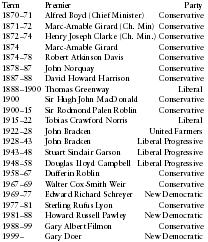
| Term | Premier | Party |
| 1870–71 | Alfred Boyd (Chief Minister) | Conservative |
| 1871–72 | Marc-Amable Girard (Ch. Min) | Conservative |
| 1872–74 | Henry Joseph Clarke (Ch. Min.) | Conservative |
| 1874 | Marc-Amable Girard | Conservative |
| 1874–78 | Robert Atkinson Davis | Conservative |
| 1878–87 | John Norquay | Conservative |
| 1887–88 | David Howard Harrison | Conservative |
| 1888–1900 | Thomas Greenway | Liberal |
| 1900 | Sir Hugh John MacDonald | Conservative |
| 1900–15 | Sir Rodmond Palen Roblin | Conservative |
| 1915–22 | Tobias Crawford Norris | Liberal |
| 1922–28 | John Bracken | United Farmers |
| 1928–43 | John Bracken | Liberal Progressive |
| 1943–48 | Stuart Sinclair Garson | Liberal Progressive |
| 1948–58 | Douglas Lloyd Campbell | Liberal Progressive |
| 1958–67 | Dufferin Roblin | Conservative |
| 1967–69 | Walter Cox-Smith Weir | Conservative |
| 1969–77 | Edward Richard Schreyer | New Democratic |
| 1977–81 | Sterling Rufus Lyon | Conservative |
| 1981–88 | Howard Russell Pawley | New Democratic |
| 1988–99 | Gary Albert Filmon | Conservative |
| 1999– | Gary Doer | New Democratic |
14 LOCAL GOVERNMENT
Manitoba has no counties or regional governments, but is divided into incorporated cities, towns, villages, and rural municipalities. In order for a community to be incorporated into a village, there must be 750 residents and a tax base of C$750,000, while towns must have 1,500 inhabitants and an assessment of C$1.5 million. An incorporated city must have a population of 10,000. Municipal elections are held every three years.
15 JUDICIAL SYSTEM
The Canadian Constitution grants provincial jurisdiction over the administration of justice, and allows each province to organize its own court system and police forces. The federal government has exclusive domain over cases involving trade and commerce, banking, bankruptcy, and criminal law. The Federal Court of Canada has both trial and appellate divisions for federal cases. The 9-judge Supreme Court of Canada is an appellate court that determines the constitutionality of both federal and provincial statutes. The Tax Court of Canada hears appeals of taxpayers against assessments by Revenue Canada.
The provincial court system in Manitoba consists of a Provincial Court, which is a trial court hearing primarily criminal matters, although it also hears youth proceedings and some family law matters; the Court of Queen's Bench, which is the highest trial court in the province, hearing criminal, civil, and family cases (both jury and non-jury cases); and the Court of Appeal, which is the highest court in the province, hearing appeals from the Court of Queen's Bench and the Provincial Court.
In 2002, there were 36 homicides in Manitoba. That same year, there were 1,644 violent crimes per 100,000 persons, and 4,977 property crimes per 100,000 persons.
16 MIGRATION
For many years, most Manitobans were of British origin. During the 1870s and 1880s, immigrants began settling in the prairie regions of Canada. German-speaking Mennonites from Russia, Icelanders, Swedish farmers from the nearby Dakota territories of the United States, English planters, and Jewish refugees from Russia all settled in Manitoba. By the 1880s, about one-third of the 120,000 people living in Manitoba and the Northwest Territories were recent immigrants.
In 2001, 11.4 percent of the 133,660 immigrants living in Manitoba had come from the United Kingdom, 19.5 percent from Southeast Asia (including the Philippines), 14.3 percent from Eastern Europe (including Poland), and 11.5 percent from Northern and Western European countries other than the United Kingdom (including Germany). In addition to large percentages of immigrants coming from the Philippines, Poland, and Germany, many immigrants come from China and India.
In 2001, about 2 percent of Manitoba's residents age 5 and older were living abroad. Some 8 percent were living elsewhere in Manitoba, while 4.1 percent were living in another province. Most interprovincial migration was with Ontario.
17 ECONOMY
Manitoba's early economy was based on agriculture, with manufacturing and transportation later becoming vital sectors. Manitoba now has a very diversified economy, but the service sector is the most important. The central location of the province makes Manitoba an attractive base for a wide variety of services, notably in transportation and wholesale distribution. In 2002, the gross domestic product totaled C$37.1 billion, or about 3.2 percent of the national total.
18 INCOME
As of 2000, average weekly earnings were C$561.82 per worker. Average family income in the province was C$60,488 in 2000 for a family of five.
19 INDUSTRY
Manufacturing is the largest goods-producing area of the economy. Food and transportation equipment have long been the leading manufacturing industries. Other important industries are primary and fabricated metals, electrical goods, clothing and textiles, and printing and publishing. In 2002, the total value of shipments by manufacturers was over C$11.5 billion. The largest contributors were food products, at C$3.02 billion; transportation equipment, C$1.6 billion; and machinery, C$1.04 billion. Furniture and related products, fabricated metals, chemicals, and plastics and rubber products were major contributors to manufacturing in 2002.
20 LABOR
Manitoba's labor force in 2003 was 596,600. About 565,500 persons were employed, with 31,100 unemployed, for an overall unemployment rate of 5.2 percent. The hourly minimum wage as of January 2004 was C$6.75.
In 2003, the sectors with the largest numbers of employed persons were: trade, 86,700; health care and social services, 73,800; manufacturing, 70,200; educational services, 42,400; accommodation and food services, 38,900; transportation and warehousing, 32,400; public administration, 32,300; agriculture, 31,000; finance, insurance, real estate and leasing, 29,700; construction, 26,700; other services, 25,800; professional, scientific, and technical services, 24,400; information, culture, and recreation, 23,400; management, administrative, and other support, 17,800; utilities, 6,200; and forestry, fishing, mining, and oil and gas, 5,800.
21 AGRICULTURE
Agriculture is the economic basis of rural Manitoba. It also supports thousands of jobs in towns and cities. Wheat is the most important crop, accounting for about a third of crop production value. The province is the leading Canadian producer of flaxseed, sunflower seeds, buckwheat, and field peas.
Of the total land area, some 25 percent has some agricultural potential. Of the 7.6 million hectares (18.8 million acres) of farm land in 2001, 4.7 million hectares (11.6 million acres) were used for growing crops. Manitoba had 21,071 farms in 2001, with nearly all of them family-operated. In 2000, the total farm receipts (excluding forest products sold) were C$3.53 billion, but farmers' operating expenses were C$3.07 billion. The average farmer was left with C$21,889 before interest payments and taxes.
The most valuable field crops are wheat, canola, alfalfa, barley, and oats. Potatoes and mushrooms are important horticultural crops. The top fruit crops are strawberries and saskatoons (also a berry).
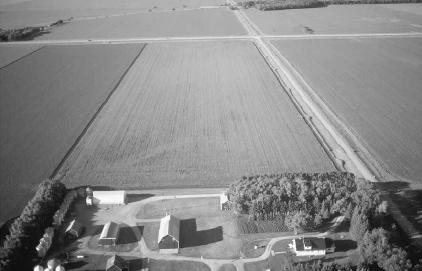
22 DOMESTICATED ANIMALS
Receipts for livestock products totaled C$1.88 billion in 2003. Manitoba's livestock population in 2004 included 1.45 million cattle. The hog population that year was 2.85 million and sheep and lambs totaled 82,000. Small numbers of pheasants, goats, rabbits, wild boars, ostriches, bison, and emus and rheas are also kept as livestock. Foxes and minks are raised for their pelts.
23 FISHING
Commercial fishing on Lake Winnipeg was common in the late 1800s, and helped Icelandic immigrants to build fishing towns including Hecla and Gimli. More recently, however, sport fishing has become an important part of the tourism industry. In 2000, there were 136,334 residents actively engaged in sport fishing in Manitoba. Fish hatcheries in Grand Rapids and Whiteshell raise trout, walleye, and other species to replenish stock. The value of fish exports from Manitoba in 2003 was C$49.1 million.
24 FORESTRY
Northern Manitoba's forests are dominated by pine, hemlock, and birch. As of 2003, Manitoba's forested area was 65 million acres (26.3 million hectares), of which 37.6 million acres (15.2 million hectares) was considered productive for timber. In 2000, the total timber cut was 77.7 million cubic feet (2.2 million cubic meters). The value of Manitoba's forestry exports in 2002 was C$615.4 million. Newsprint made up 22 percent of all wood product exports. There were 7,300 persons directly employed in the forestry industry in 2002.
25 MINING
Mining is another major Manitoba industry. Metals account each year for at least three quarters of the total value of mining production in the province. The most important metals are nickel, copper, and zinc (the province is a world leader in the production of nickel). Manitoba also produces a number of industrial minerals. Production in 2003 included 84,166 tons of zinc, 38,072 tons of nickel, 28,906 tons of copper, 26 tons of silver, and 3,963 kilograms of gold. The total value of metallic mineral production in 2003 was C$768.7 million. The total value of nonmetallic minerals was C$102.5 million.
26 ENERGY AND POWER
In 2002, crude oil production totaled 22.9 million cubic feet (650,749 cubic meters), valued at over C$150 million.
The major rivers of western Canada flow into the lowland region of Manitoba, giving Manitoba 90 percent of the hydro-electric potential of the prairie region. More than 94 percent of the electricity generated in the province is provided by Manitoba Hydro, which has 14 hydroelectric generating stations on the Nelson, Winnipeg, Saskatchewan, and Laurie Rivers, and 2 thermal generating stations. Total electrical capacity in Manitoba is 5.4 million kilowatts.
Total revenues from electricity and natural gas sales were 1.86 billion in 2001/02. This represented 1.38 billion in electricity sales and 0.48 billion in natural gas sales. Manitoba Hydro is also the principal distributor of natural gas in the province. Exports of electricity to other provinces and to the US totaled 588 million in 2001/02.
27 COMMERCE
In 2002, total merchandise exports amounted to C$9.6 billion. Imports totaled C$11.3 billion. The United States was by far the largest export market (C$7.7 billion), followed by Japan, Mexico, Belgium, and Hong Kong. The United States was also the largest import supplier (C$8.4 billion), followed by France, China, Mexico, and Germany.
Agricultural trade is Manitoba's primary commercial base. The food processing industries in Manitoba rely on the various service sectors in the province, including transportation, construction, finance, insurance, and real estate. About six percent of all transportation expenditures in the province involve the movement of raw or processed agricultural products, and about six percent of all construction projects either are on farms or are for agriculture-related industries. Some 14 percent of provincial expenditures for financial, insurance, and real estate services are derived from farms. Manitoba farms also annually account for 4.5 percent of the electricity, 58 percent of the chemicals, and 29 percent of the gasoline and fuel oil consumed in the province.
28 PUBLIC FINANCE
The fiscal year extends from 1 April to 31 March. For the fiscal year ending 31 March 2003, total revenues were estimated at C$6.94 billion; expenditures were C$6.99 billion. Major expenditure areas were health, education and training, family services, economic and resource development, interest on debt, government services, and assistance to local governments and taxpayers. In the 2002/03 fiscal year, provincial debt amounted to 19.9 percent of the gross domestic product, or C$7.16 billion.
29 TAXATION
The basic personal income tax rate in 2003 was 46.3 percent. The retail sales tax was 7 percent. Major consumption taxes are levied on gasoline (C$0.115 per liter) and tobacco (C$29 per carton).
The average family of four (two parents and two children) in 2003 earned C$73,977. Such a family paid C$34,522 in taxes.
Corporate income tax rates in 2003 were as follows: small business rate, 5 percent; general business rate, 16 percent; and capital tax rate, 0.5–3 percent.
30 HEALTH
In 2001, there were 14,002 live births in Manitoba, a decrease of 0.6 percent from 2000. There were 9,734 deaths. Life expectancy for men in 2001 was 75.6 years, and 81.5 years for women. Reported cases of selected diseases in 2002 included gonococcal infections, 626; campylobacteriosis, 209; salmonellosis, 200; and giardiasis, 153. Between November 1985 and June 2003, 1,025 residents had become infected with HIV, the virus that causes AIDS.
31 HOUSING
Manitoba had 432,555 households in 2001, with an average size of 2.5 persons. There were 298,230 households living in single family detached homes, 37,625 households living in apartments in buildings with five or more stories, 7,605 households living in mobile homes, and 89,100 households living in other dwellings, including row houses and apartments in buildings with fewer than five stories. A total of C$1.1 billion was invested in residential construction in 2002.
32 EDUCATION
Manitoba had 230,000 students enrolled in its elementary and secondary schools in 1999/2000, a 3 percent increase over 1998/99. The student-teacher ratio was approximately 15 to 1.
The University of Manitoba in Winnipeg was established in 1877 and is western Canada's oldest university. It had about 21,000 full-time students in 2003/04. Winnipeg is also the site of the University of Winnipeg, where 6,000 full-time students were enrolled in 2003/04. Brandon University, which has a school of music, offers special Aboriginal education programs. In 2003/04, Brandon University enrollment was 2,500. Le Collège universitaire de Saint-Boniface, with class offerings taught entirely in the French language, had an enrollment of 3,800 in 2003/04.
33 ARTS
Manitoba's performing arts companies give over 1,500 performances before a total attendance of nearly 800,000. The Royal Winnipeg Ballet was founded in 1939.
Other performing arts in Winnipeg include the Winnipeg Symphony Orchestra, the Manitoba Opera and several classic and contemporary theaters, including one that features productions in French. The video and film industry is rapidly expanding. There are over 14,000 arts and cultural workers in Manitoba.
The province has one of the highest per capita revenue and attendance levels for arts and culture in Canada. Manitoba has the second-highest per capita spending on the arts, at C$104 (the national average is C$67). The Manitoba Arts Council provides funding for the arts. In 2002/03, the Canada Council for the Arts provided grants worth C$6.4 million to the arts in Manitoba. Music received the highest amount of funding, followed by dance and theater.
34 LIBRARIES AND MUSEUMS
The Winnipeg Public Library's main branch, the Centennial Library, closed November 1, 2003, for extensive renovation. It was scheduled to reopen as the Millennium Library in early 2005. The 20 branches of the WPL will serve patrons during the renovation period.
The Winnipeg Art Gallery houses the world's largest collection of modern Inuit art, in addition to a collection of contemporary, historical, and decorative art. Also located in Winnipeg are the Western Canada Aviation Museum, the Manitoba Children's Museum, the National Aquatic Hall of Fame and Museum of Canada, and the Wildlife Museum. The Marine Museum of Manitoba is located in Selkirk.
35 COMMUNICATIONS
As of 2004, Winnipeg had 8 AM and 29 FM radio stations, and 4 television stations.
36 PRESS
Daily newspapers in Manitoba include the Winnipeg Sun, the Winnipeg Free Press, The Brandon Sun, and the Flin Flon Reminder.
37 TOURISM, TRAVEL, AND RECREATION
Revenues from tourism in 2001 were estimated at C$1.29 billion. The industry employed an estimated 60,200 persons. Sixty percent of tourism revenues comes from visits and activities of Manitoba residents. Twenty percent of revenues is derived from visitors from other Canadian
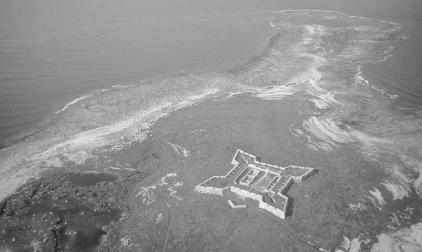
Campgrounds, parks, lakes, rivers, and historic sites are the principal attractions for Manitoba's visitors. Both tourists and Manitobans alike can also take advantage of the province's 124 golf courses, most of which are open to the public. Lake Winnipeg is the seventh-largest freshwater lake in North America and the thirteenth-largest in the world.
Tourism additionally relies on dozens of community festivals, a number of which have international reputations. Winnipeg's Folklorama is an elaborate two-week summer multicultural celebration. The Jazz Winnipeg Festival in June is Canada's only thematic jazz festival. Other ethnic events include the Winnipeg Folk Festival, Festival du Voyageur, and Oktoberfest. Canada's National Strawberry Festival is held in Portage la Prairie.
The Royal Winnipeg Ballet is the longest continuously operating ballet company in North America. The International Peace Garden at the province's border with North Dakota is the world's largest garden dedicated to peace.
38 SPORTS
Manitoba is the home of the Winnipeg Blue Bombers of the Canadian Football League (CFL). The Blue Bombers were the CFL champions in 1958, 1959, 1961, 1962, 1984, 1988, and 1990. The Manitoba Moose of the International Hockey League play their home games in the Winnipeg Arena. The Winnipeg Jets of the National Hockey League (NHL) moved to Arizona in 1996 to become the Phoenix Coyotes. The Double-A professional baseball team, the Winnipeg Goldeyes, play in the independent Northern League.
39 FAMOUS MANITOBANS
Controversial hero/outlaw Louis Riel (1844–85) was the founding father of Manitoba and leader of the Métis rebellions of 1870 and 1885. Nellie McClung (b.Chatsworth, Ontario, 1873–1951), an activist and author from Manitou, was instrumental in women's suffrage being attained in Manitoba in 1916.
Noted Manitobans in entertainment include television host Monty Hall (b.1925), singer Gisele MacKenzie (1927–2003), and magician Doug Henning (1947–2000). All three were born in Winnipeg. Singer-songwriter Neil Young (b.Toronto, 1945) moved to Winnipeg as a child. The rock group Crash Test Dummies is from Winnipeg.
Celebrated Manitoban authors include historian and journalist George Woodcock (1912–95), novelist Adele Wiseman (1928–92), and historian William L. Morton (1908–80). Margaret Laurence (1926–87) used her hometown of Neepawa as the inspiration for the town of Manawaka in her novels. Gabrielle Roy (1909–83) was a noted francophone (French-language) author. Winnipeg soldier Harry Colebourne bought a mascot for his regiment in World War I, naming it Winnie, after his home town. Colebourne's bear became the inspiration for British author A. A. Milne's Winnie the Pooh.
Manitoban hockey stars include Robert Earle "Bobby" Clarke (b.1949), from Flin Flon; Walter "Turk" Brody (1914–72), from Brandon; and Bill Mosienko (1921–94) and Terry Sawchuck (1929–70), both from Winnipeg.
40 BIBLIOGRAPHY
Bumsted, J. M. The Peoples of Canada. New York: Oxford University Press, 1992.
Emmond, Ken. Discover Canada: Manitoba. Toronto: Grolier, 1991.
Laws, Gordon D. Manitoba. San Diego: Lucent, 2003.
LeVert, Suzanne. Manitoba. Philadelphia: Chelsea House, 2000.
Sorensen, Lynda. Canada: Provinces and Territories. Vero Beach, FL: Rourke, 1995.
Web sites
Government of Manitoba. http://www.gov.mb.ca/splash.html (accessed on March 22, 2004).
Statistics Canada. http://www.statcan.ca (accessed on March 22, 2004).
Travel Canada: Manitoba. http://www.travelcanada.ca/tc_redesign/app/en/ca/destinations.do?provinceId=4 (accessed on March 22, 2004).
Travel Manitoba. http://www.travelmanitoba.com (accessed on March 22, 2004).
Comment about this article, ask questions, or add new information about this topic: